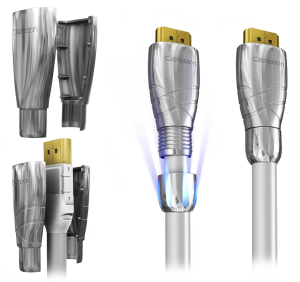What is HDMI 2.0a?
HDMI 2.0a is the latest HDMI spec announced by HDMI Licensing that regulates cables, inputs and outputs connecting almost everything in your home entertainment centre. The new feature of this specification ensures and governs High Dynamic Range content between HDR-compatible source devices and TVs.
This is a minor update, but a potentially major one for 2015 and beyond. Right now, the most important to know is that; HDMI 2.0a is not a change in cable, compared to the previous change from HDMI 1.4 to 2.0. Which implies that your current HDMI cables should work fine!
The main changes have to do with chips inside the source devices and TVs, not the cables themselves. The cable is just a dumb pipe, implying that it does not matter if the data going through it is High-Def video, 4k video, standard-def video, which is all just a variation on a theme.
It is even possible that you may never see written anywhere on TV specifications sheets “HDMI 2.0a”. The same that happened with HDMI 2.0.
What Changed?
The change has to do exclusively with High Dynamic Range (HDR) content. Not to be confused with HDR for cameras, HDR for TVs promises better realism thanks to brighter whites and some other improvements. However it requires a compatible TVs, source devices and specialized content.
“The specification has been updated to unable transmission of HDR formats, which procures enhanced picture quality by simultaneously enabling greater details for both the dark and bright parts of an image. The HDR-related updates include references to CEA-861.3, CEA’s recently published update of HDR Static Metadata Extensions.”
HDMI Forum, Inc. 8 April 2015
In essence, the change is just specifications on how to transmit HDR metadata. That’s information layered on top of the video image that tells the HDR-compatible display how to best take advantage of the greater color and contrast range in the underlying video image. So, for instance, a theoretical future 4K Blu-ray player can take the shadowy scene in a dark village and “tell” the display exactly how to render it in its HDR-enhanced glory.
Notably, the spec doesn’t regulate streaming connections directly from the Internet to a TV – for example, HDR from Amazon or Netflix (coming later this year) – just those from HDMI sources. That’s because streaming connections skip HDMI entirely, allowing direct communication between the Internet and the TV’s decoder, which typically use HEVC (High Efficiency Video Coding) or VP9 compression for 4K video.
What does it mean to you?
The main thing to know is that HDMI 2.0a will only be relevant to new, high-end TVs that can accept and display HDR content. Most of the 4K TVs and non-4K announced in 2015, including numerous high-end models such as LG’s 2015 OLEDTVs, don’t support HDR. They don’t need HDMI 2.0a and have no use for HDR signals, via HDMI or otherwise.
The only TVs we know about for 2015 that do support HDR are Samsung’s SUHD line, Vizio’s Reference series, Panasonic’s CX850 and two of Sony’s most-expensive XBR models.
When TVs’ manufacturers got contacted about if their sets would be compatible with HDMI 2.0a, only Sony confirmed that the XBR-75X940C and XBR-65X930C would be compatible. Others manufacturers were more vague, suggesting their sets would be compatible in “future” or will need upgrade.
Bottom Line
HDMI 2.0a is not a big change, and it likely won’t affect you right now, but we would like to hedge against the inevitable claims of cable purveyors. Next time someone will say “HDMI 2.0a compatible cables” (for very probably a very expensive price) tell them you will save some money and 2.0 cables instead!!
All our Cablesson and XO HDMI cables and hardware are compatible HDMI 1.4 and 2.0!!!


